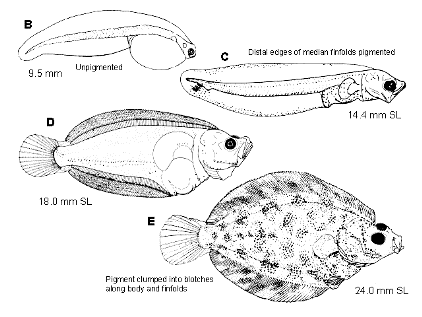The Journey of the Left Eye
 Pacific
halibut
breed during the
winter from November to January, away from costal waters and at
depths of 275 – 415 feet.
Females lay between two to three million eggs annually.
When the eggs are fertilized by the males they become buoyant and
begin to float towards the water surface. They will hatch after about 16 days.
When the free-floating larva emerge, they will continue
to rise to the surface and drift towards shore via currents.
During this time, they will undergo a flatfish-unique
metamorphosis. When the halibut larvae hatch, they resemble the larvae of all
other fish. During
three to five months of age, during their journey towards shore, the left eye will begin migrating
towards the right side of the body.
The larvae will slowly change form and become laterally
flattened, a distinctive characteristic.
When the small flounder-shaped fish reaches the shallow
waters, it will become a bottom-dweller.
Pacific
halibut
breed during the
winter from November to January, away from costal waters and at
depths of 275 – 415 feet.
Females lay between two to three million eggs annually.
When the eggs are fertilized by the males they become buoyant and
begin to float towards the water surface. They will hatch after about 16 days.
When the free-floating larva emerge, they will continue
to rise to the surface and drift towards shore via currents.
During this time, they will undergo a flatfish-unique
metamorphosis. When the halibut larvae hatch, they resemble the larvae of all
other fish. During
three to five months of age, during their journey towards shore, the left eye will begin migrating
towards the right side of the body.
The larvae will slowly change form and become laterally
flattened, a distinctive characteristic.
When the small flounder-shaped fish reaches the shallow
waters, it will become a bottom-dweller.
 The juveniles will reside in the shallow waters,
gradually moving outward as they mature.
Although mature halibut have been recorded at
depths of up to 1100 meters, they are most often located between 55
and 410 meters.
Females will be
fully-grown and reach sexual maturity between the ages of eight
to twelve years and males between seven and eight.
Pacific halibut demonstrate significant sexual dimorphism
in length and size, with females growing much larger.
The average weights of females and males are 45 and 30
kilograms, respectively.
The juveniles will reside in the shallow waters,
gradually moving outward as they mature.
Although mature halibut have been recorded at
depths of up to 1100 meters, they are most often located between 55
and 410 meters.
Females will be
fully-grown and reach sexual maturity between the ages of eight
to twelve years and males between seven and eight.
Pacific halibut demonstrate significant sexual dimorphism
in length and size, with females growing much larger.
The average weights of females and males are 45 and 30
kilograms, respectively.
The image above demonstrates how the slightly differentiated, unpigmented larva develops through its first five months. Pigmentation begins after a week, and the eye begins its migration to the right side of the body around two and a half weeks. By five months, the left side of the larvae will be completely white. Consecutively, the right side of the body will have acquired a darker, brownish-grey hue. Chromatophores differentiate only on the dark side to allow the halibut to imitate the ocean bottom. Once the larva starts becoming two-toned, it gains a significant amount more camouflage from predators when orientating itself laterally. As you can imagine, from below, the white underside blends in with the sky. Conversely, from above, the upper portion of the young fish blends very well with the sea floor. This double-sided camoflauge of the young halibut helps it stay out of sight of bigger, hungry fish, but it also helps hide it from prey, increasing its chances of catching a meal.
The picture below and to the left most likely shows a massive female halibut. Typically, males won't grow to this size. For a size comparison, the picture to the right shows average, mature male halibut body lengths. Also, notice how the backside of the halibut is nearly "snow-white."
